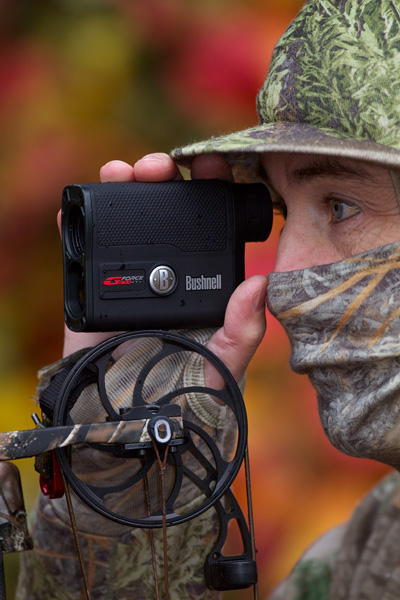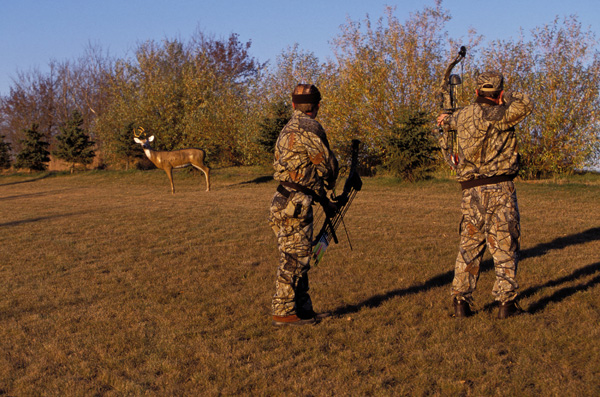Life on the Ledge: Judging Yardage 
Story and photos by Lon E. Lauber
Shooting at Alaska big game presents a unique set of problems for the bowhunter. They live in such diverse terrain; they are frequently hunted in extreme weather and they vary dramatically in size from hundred-pound deer to nearly a ton of bison. And, regardless of size, habitat or weather, one of the biggest challenges of bowhunting is judging distance to the target animal. Mis-guessing the distance to the target, by only a few yards, is perhaps the most common reason archers miss game when bowhunting. Even with high tech, modern bows, there is still plenty of arc in an arrow’s flight path. Without question, the best way to judge yardage is to make use of a modern laser range finder, preferably one with angle-compensation features.
However, there are many hunting scenarios when laser ranging is not practical or too time consuming. So, nothing will ever take the place of being able to accurately gauge distance by eyeballing it quickly. Learning to judge yardage takes practice.
Eyeballing distance
There are several little tricks archers can use to help train themselves to judge distance. The first is to practice the skill constantly, just as you would shooting. When walking down the street, look at a car in the parking lot or the distance to the store’s doorway and guess how far away it is. Then pace off the distance to see how close your guess was. Continually doing this will sharpen your distance-judging abilities quickly. However, you must first learn to take strides that are about one yard each for this to help.
Don’t try and judge distance to the exact yard at first. Instead, use larger increments, like five yards. Later when you’re starting to sharpen your eye, try and guess the distance to the precise yard.
One of the best ways to estimate yardage is by using a personally familiar distance and use it as a gauge. For me, I always use 20 yards as my first increment. I tr my best to determine the distance to the target animal ass compared to what my experience says n 20 yards. If it’s a few yards less than 20 then I guess 17 yards. If ti’s more than 20 I pick an object at what I believe is 20 yards away and then add additional yardage to come up with my estimation. If a target animal is more than two, 20-yard segments (40 yards) away, I’ve found my estimation skills fall off dramatically and if at all possible, I use a laser range finder.
If time prior to the shot allows, I use the 20-yard gap method and then also try determining what I believe is halfway to the target animal and double that number. These two techniques must be practiced all the time or you are really handicapping yourself come hunting season.
I’d recommend, after properly tuning and sighting-in your bow, spending the majority of your practice time walking around and stump shooting or shooting at life-size 3D animal targets at unmarked yardage. This type of practice will fill more tags than static repetition at the target range (which you need to do initially).
Another way to help judge distance is by using your bow’s sight pins. Say you set your sight pins so your arrows will hit dead-on at 20, 30, 40 and 50 yards. There will be a gap between the pins that can be used as a poor-man’s range finder. Using a life-sized 3D deer target, stand back at 30 yards, lift your bow, and place the 20-yard pin on the deer’s back line. Look how far down the animal’s body the 30-yard pin is (in this case it should be about in the middle of the vital zone). Now move back to 40 yards, and place the same 20-yard pin on the deer’s back line. The 30-yard pin should now be somewhere between the center of the vital zone and the deer’s back line. By doing this at all common shooting distances, and remembering what the sight picture looks like at each distance, you’ll be able to take a relatively accurate distance measurement. But, with the great variety in size of Alaska game animals you must “calibrate” this method to the back-to-brisket size of each species, whether it’s a big bull moose or a smaller Sitka blacktail.

Range Finders: A Valuable Tool
A quality bowhunting range finder can help take the guesswork out of the all-important distance guesstimating equation. Laser range finders have become much smaller and more precise over the years. And the best ones for bowhunting, particularly in steep terrain frequently found in Alaska, are the ones with angle-compensation features. The user simply sights through the viewfinder and presses a button that sends a laser beam to the target. The built -in computer calculates the distance and steepness and then provides a read out that has compensated for the angle of the shot. Please understand that gravity affects the arrow’s trajectory across the horizontal distance of its flight, not the angled distance. The manufacturers have the algorithms figured out pretty well. The readings are extremely accurate, and can be seen in the viewfinder. I’ve used most all the current range finders extensively and had very good luck with Bushnell, Nikon and Leupold range finders.
With this technology, the best way to improve your yardage estimation skills is to eyeball the distance first, verify with a laser range finder that you have used to sight-in your bow, and then shoot for the distance the range finder suggests, not your guess. By cause and effect, time after time of “guessing” manually and then verifying with the range finder you can hone your yardage estimation skills quite well.
Don’t rely strictly on the laser range finder because there are many times when hunting that you won’t have time to range. That’s when year-round estimation skills can make or break your hunting trip.
###
Lon E. Lauber, contributing editor for Hunt Alaska magazine, is a nine-time Alaska state archery champion and holder of 51 Pope and Young trophies.
